
Worldcarblog.com
BMW X7 review
For those that want the finest luxury that BMW has to offer in SUV form, then the X7 is the answer. It is of course packed with the latest technology and driver aids, yet at well over five metres long it also has the fundamental provision of space in abundance. Naturally, that puts it squarely in the sights of popular large SUVs such as the Mercedes-Benz GLS and Range Rover, but BMW’s recent form in this department has been excellent.
And sure enough, there’s lots to like about the X7 – even more so after its facelift in late 2022. The styling is still controversial, but the rest of the car exudes all the luxury and premium quality that you’d expect of a high-rise 7 Series. Three rows of seats make for a standard seven-seat configuration, while a six-seat variant is also on offer for those that want more space in the second row.
Meanwhile, engine choices have been updated for 2022 with the xDrive 40i getting performance and efficiency tweaks, while the range topping M50i xDrive is now badged M60i xDrive. In addition, the xDrive30d and M50d models have been rolled into one, badged xDrive40d. All variants get xDrive all-wheel drive, an eight-speed automatic gearbox and 48-volt mild-hybrid technology as standard.
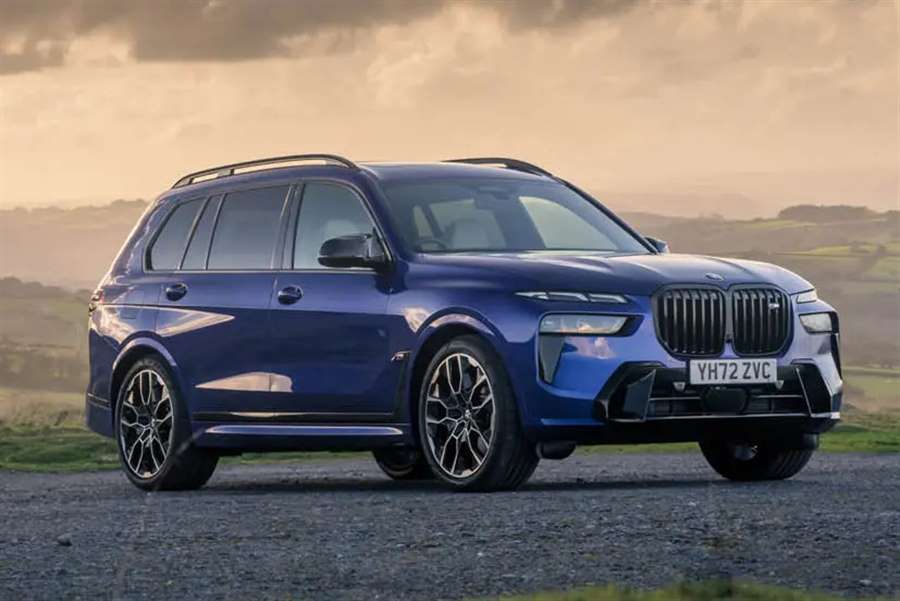
As for trim levels, there’s a choice of three on UK models, ranging from entry-level Excellence spec, through to M Sport and top-spec M50i xDrive. In truth, you’ll never be wanting for equipment regardless of which variant you get, with all versions getting luxuries such as a panoramic glass sunroof, adaptive LED headlights, air suspension and much more.
Post-facelift cars also get the same infotainment setup as the newest 7 Series and i7 models, meaning a 12.3-inch digital instrument panel and 14.9-inch curved central screen that runs BMW’s latest iDrive operating system. Predictably, it’s one of the best on the market even if it does take a little time to get used to the myriad features and functionality.
Click through the next few pages to read everything you need to know about the BMW X7, including its practicality, how much it costs to run, what it’s like to drive – and whether we recommend buying one.
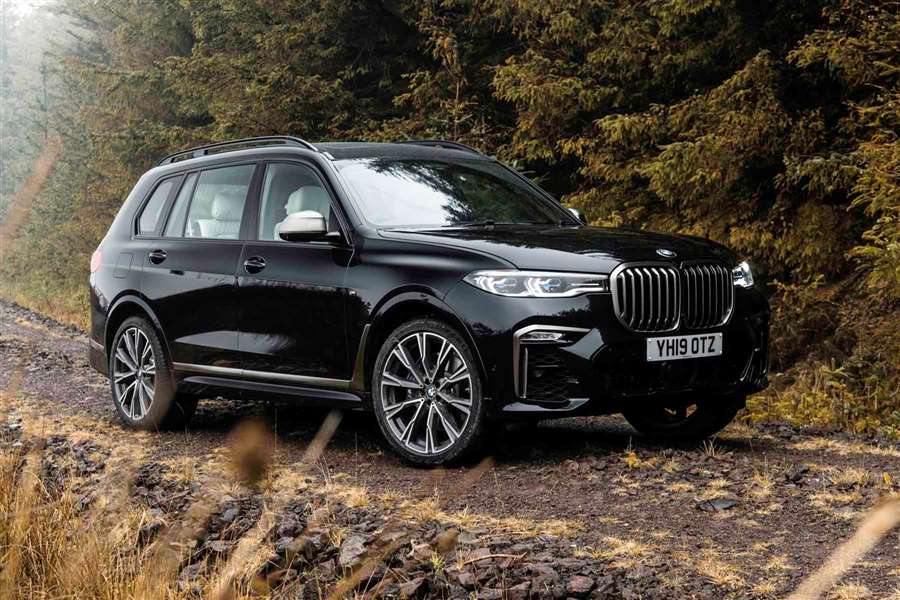
BMW X7 boot space, practicality and safety
How much space is there?
That upright bodywork liberates a considerable amount of interior space, but it’s unlikely you’ll feel inclined to risk damaging the high-quality interior furnishings by turning it into a makeshift van.
All X7s have three rows of seats, just like the similarly sized Audi Q7, Land Rover Discovery and Mercedes-Benz GLS, but BMW offers the option of specifying two individual middle-row captain’s chairs instead of a bench with a trio seats to customers wanting a bit more comfort. With these captain’s chairs, which turns the X7 into a six-seater, you get a much wider range of adjustment and a pair of armrests to feel more like a seat found in the front of the car.
In either configuration, the middle-row seats are electrically adjustable making them exceptionally comfortable, but while having them move forwards out of the way to access the third-row seats is also electrically powered, they operate at such a pace that you’ll get wet on a rainy day waiting to climb aboard.
Passengers in row two can slide the bench back or forth by up to 14.5cm, as well as tilt the backrest, and foot-space is generous with an almost flat floor.
Climbing back to row three is a bit tight, but there’s generous room for fully grown adults once seated (as long as the middle is moved forwards slightly), with armrests, cupholders, heated seats and, optionally, air vents and a climate-control panel.
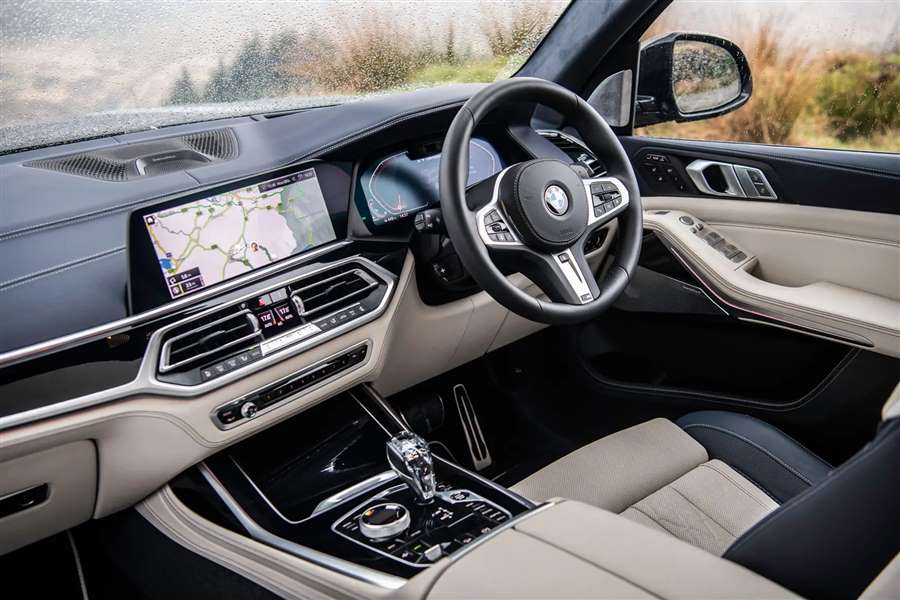
BMW X7 rear seats
Although the side windows are rather small for the rearmost row, it still feels airy thanks to an elevated view ahead and high roof, a separate glazed roof panel overhead, third-row-specific climate control buttons and ambient lighting strips just like the rest of the cabin.
There are Isofix child-seat anchors too, so you’re not forced to clip small kids into the middle row, which also makes accessing the third row harder.
The more opulent six-seat version is more comfortable and spacious for six, and the gap between the seats makes it easier to walk through to the back row – just.
Boot space and storage
The boot area is spacious, well-trimmed and peppered with electrically powered conveniences. The tailgate is horizontally split – both sections operate electrically – while the lower portion can be used as a seat, able to hold a combined weight of 150kg.
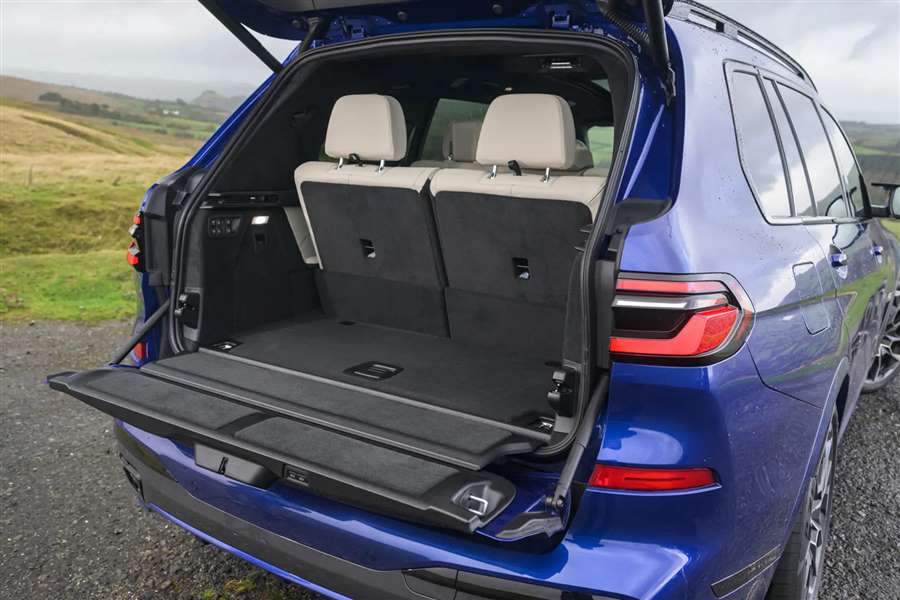
BMW X7 boot
As you would expect, the boot volume is limited (326 litres) when all seven seats are upright with enough space for a couple of squashy overnight bags, but with all rear seats folded, total capacity is a cavernous 2,120 litres. In five-seat mode, it offers 750 litres of space.
Should you need to load some heavy cargo into the boot, you can also lower the car by 40mm to help slide it in thanks to standard-fit air suspension.
If you’d like to use your X7 for towing, then there’s further good news: factory-fitted tow bars are available and all versions can haul up to 3.5 tonnes where trailers are fitted with brakes.
BMW X7 safety
The X7 hasn’t been tested by Euro NCAP as yet, but the latest X5 has and received a five-star rating, so there’s little reason why the larger, more expensive X7 should fare any differently. A suite of airbags throughout the car should ensure the occupants are kept safe in the event of an accident, while a wide array of safety and driver assistance tech is available.
On post facelift models, the standard-fit front collision warning detects oncoming traffic when turning right, as well as pedestrians or cyclists when turning left. Included in the Driving Assistant Professional package and Lane Change Assistant, meanwhile, is Active Cruise Control, Steering and Lane Control Assistant plus Active Lane Change and Merging Assistant.
Also featuring on post facelift X7s is Manoeuvre Assistant. This can store individual manoeuvres that can then be replicated by the car when a pre-determined location is reached. So for example, if you need to navigate your X7 into a tight underground parking spot, the Manoeuvre Assistant can take over the accelerator, steering and gearshifts. From 2023, this will also be available from the BMW mobile app.
BMW X7 interior, tech and comfort
BMW X7 interior
All-round quality in the X7 is superb – as you’d expect from an SUV that’s priced from over £80k. The large screens present a strong digital feel to the cabin, yet there’s still plenty of good old-fashioned luxury present in the choice of materials. Merino leather is lavished throughout the cabin, while fine wood and the ambient lighting bar add a real sense of exclusivity.
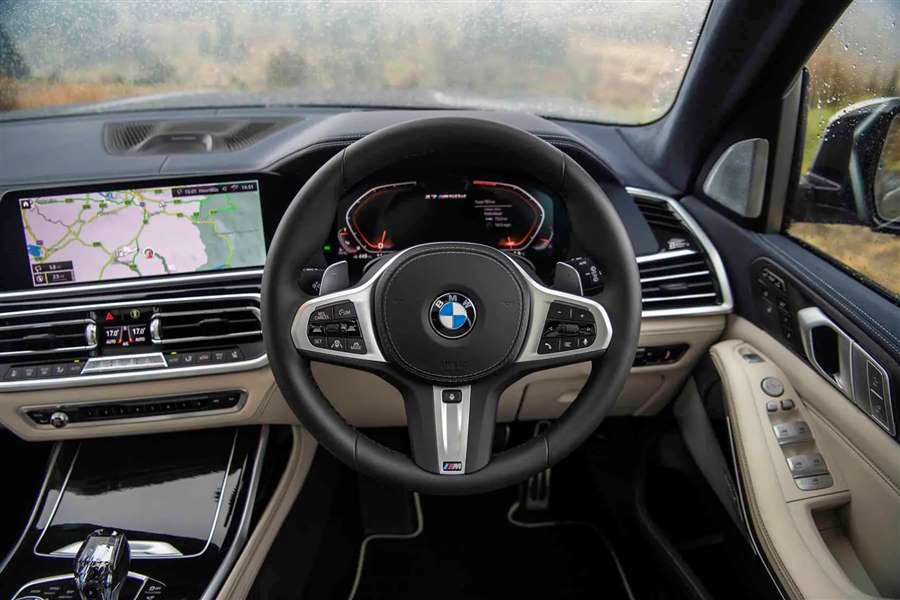
The centre console area is fairly minimalist, yet there’s still buttons for the infotainment system as well as the iDrive rotary controller. Sadly, physical climate control switches have been jettisoned yet the icons to change the temperature are ever-present on the central touchscreen.
Infotainment and tech
There’s a high-tech feel to the media system too. BMW’s latest 8.0 iDrive infotainment is standard, with a 12.3-inch digital instrument panel and 14.9-inch curved central screen on post facelift models. It’s operated via either a rotary controller, touchscreen, voice control or gestures (including twirling a finger to adjust volume), or a mixture of all of the above.
BMW X7 interior and infotainment
If it sounds confusing, it’s soon intuitive, with BMW’s iDrive system showing why it’s one of the best on the market at any price point. The graphics and menus look sharp, while the responsiveness and functionality is second-to-none.
Key to the luxury levels in the X7 are standard-fit comfort seats for the driver and passenger. Boasting fully electric adjustment of the seat position and head rest height, they are extremely supportive and make even the most arduous of journeys fly by. Heated seats are standard, while active seat ventilation and massage functionality is available as an option.
Meanwhile, ride comfort and refinement on the standard air suspension is deeply impressive. Cracks and lumps in the road are ironed out, while the amount of noise making its way into the cabin is surprisingly low given that you’re enclosed inside a 2.6-tonne SUV punching a hole in the air. Post-facelift cars are available with 23-inch alloy wheels and while we’re yet to sample them, the ride will likely still be serviceable – if not quite as imperious as versions with smaller alloys.
BMW X7 running costs and reliability
Diesel engines 3.8 - 4.5 mppLow figures relate to the least economical version; high to the most economical. Based on WLTP combined fuel economy for versions of this car made since September 2017 only, and typical current fuel or electricity costs.
Fuel economy
Petrol engines 21.7 - 29.4 mpg
Diesel engines 31.0 - 36.7 mpg
BMW X7 front
A car the size of the X7 won’t be especially cheap to run in any form, but go for the least-expensive diesel and it shouldn’t be too bad. The xDrive40d claims between 32.8-36.7mpg under the latest WLTP testing regime that better replicates real-world fuel efficiency.
Beyond that model, the X7’s a thirsty beast, particularly if you like to exploit the engines’ power and torque. The entry level petrol – xDrive40i – claims 26.4-29.4mpg, while the high-performance M60i xDrive returns 21.9-23.3mpg.
Servicing and warranty
As with other BMWs, the X7 is available with a number of service plans including one where an upfront payment will cover at least the first four years’ worth of services. BMW also offers monthly service plans. In addition, the X7 comes with a three-year unlimited mileage warranty – with breakdown cover – as standard.
BMW has a fine reputation for building cars that are dependable – especially when it comes to the mechanical components such as engines and gearboxes – so there shouldn’t be too much cause for concern as the X7 makes use of engines that are already found in several other BMW models.
Where you might find a little bit of trouble is with the company’s latest infotainment system. While it’s slick in operation with endless facilities, we’ve found in other models it can be a little unresponsive at times, with hit-and-miss voice control and connectivity issues in some cases. If this is a problem, a software update should fix it as with any other car.
BMW X7 engines, drive and performance
The BMW X7 is available with three engines in post-facelift form, ranging from the xDrive40d and 40i versions to the performance focused M60i xDrive variant. All come with 48v mild-hybrid capability, aiding efficiency and responses.
Starting with the xDrive 40i, it offers an impressive combination of 340hp, 5.8-second 0-62mph time and 26.6-29.4mpg. The six-cylinder turbocharged unit is smooth even at high revs, pulls keenly from low speeds and feels perfectly fast enough at full throttle. The purposeful but subdued exhaust note fits the bill, too.
If you can stomach the high running costs (it’s got a big car to haul around), it’s a very satisfying car to drive in this form. It feels eager without being too frantic, and beautifully smooth and refined in its power delivery, thanks in part to the slick eight-speed automatic gearbox. It’s also quick to respond when you put your foot down or take manual control via the paddles.
You can also tweak how response the steering, throttle and gearbox is via the drive mode selector – standard on all models. There’s a choice of Eco Pro, Comfort, Sport and Adaptive, with an Individual mode available for the Sport mode.
If you want more power, then the M60i xDrive version should have you covered, delivering 530hp from its 4.4-litre V8 and accelerating from 0-62mph in just 4.7 seconds – hugely impressive figures for such a big car.
Aside from raw numbers, the powertrain is smooth and makes a satisfying noise under load. Torque is also prodigious, with 750Nm on tap meaning acceleration from low revs is almost as impressive as the 0-62mph sprint. We’d perhaps question if this engine is entirely necessary, but if you want the absolute ultimate performance and refinement in your X7 then this is it.
For those that want diesel, the xDrive40d is the only option and produces 352hp and 720Nm of torque (the latter almost as much as the M60i). That means 0-62mph in 5.9 seconds, as well as much more respectable fuel economy that should settle in the mid-thirties. We haven’t driven this variant yet, but sufficed to say it may well be the best compromise of the current engines on offer.
What’s it like to drive?
For the engineering team in charge of developing the X7, the primary challenge wasn’t simply to make it comfortable – that’s comparatively easy. Instead, the hard work comes in terms of making it feel like a BMW, and on that score, it delivers.
Of course, it’s not as agile as a 1 Series Sports Hatch or a 3 Series Saloon, but that the X7 is comparable with a 7 Series is remarkable given its sheer size and elevated ride height. Air suspension is fitted as standard, allowing for greater suppleness in ride quality and more adjustability between the drive modes of Eco Pro, Comfort (the default setting) and Sport. Those air springs also endow the X7 with greater off-road ability thanks to the system that allows for up to 80mm of adjustment.
With the standard steering, Sport mode feels suitably weighty, encouraging you to hustle the BMW along, but the car’s more nimble overall with the optional Integral Active Steering (four-wheel steering) package. You lose a little bit of feel and weighting through the steering wheel, but gain because the rear wheels have up to three degrees of steering input, too. This is especially noticeable at lower speeds, a you can turn the X7 in a much tighter area than you’d expect it to.
At motorway speeds, they turn in the same direction as the front wheels for increased stability, which BMW claims improves passenger comfort as there’s less lateral movement for passengers in the back along curves in the road.
When speeds are much lower, they point in the opposite direction to the fronts, making the X7 even more manoeuvrable. Combine this with BMW’s Active Roll Stabilisation that prevents the car leaning so much when cornering, and it feels impressively responsive.
Is the BMW X7 also capable off-road?
BMW doesn’t really talk up the X7’s all-terrain credentials, but the xOffroad package is optionally available with modes for sand, rocks, gravel and snow.
While virtually no X7 customers will take their cars off the beaten track, BMW’s engineers understand that for it to be seen as credible, it has to be able to go off-road for the few who want to.
The four-wheel drive package, air suspension and trick steering system, which help make the X7 so capable on tarmac, also allow it to impress off-road, aided and abetted by Hill Descent Control – think of it as a low-speed cruise control for all-terrain driving.
We’ve tried the car on a very challenging off-road course meandering up and down hills, through a tight and twisty wooded area, as well as some tricky terrain that’s normally traversed by Land Rover Defenders – including some parts of river and loose, rocky inclines. It would have been challenging to walk it, let alone drive it, yet the X7 proved more than its match.
Whether it’s more capable than the similarly-sized, but lower-priced Land Rover Discovery isn’t immediately clear, but even if it’s not quite as good, the fact that it’s a discussion point illustrates how able the BMW is.
BMW X7 verdict
Yes, with provisos. If you don’t need seven seats, then the Range Rover just edges the X7 in terms of opulence and prestige, but for fit and finish, more cutting edge technology and a sportier driving experience, the BMW shade’s Land Rover’s icon. Of its German-badged rivals, we’d take the X7 over the Audi Q7 and Mercedes-Benz GLS without hesitation – it’s simply more polished and, providing you can live with its looks, more desirable.
But there’s the rub. The BMW X7 polarises opinion on account of its sheer mass and bluff, glitzy front end, but there’s actually a lot to enjoy once you’re onboard. Quality is impressive, the vast array of technology available is easy to operate, there’s plenty of room and it doesn’t feel too intimidating on the road. Plus, there isn’t a bad engine available. There’s no doubt its mix of luxury, versatility and dynamic ability is unmatched by anything else in this segment at comparable money.
What we like
This is an undoubtedly huge car that’s crammed with tech, yet it’s still more enjoyable to drive than many smaller vehicles. That’s because BMW prides themselves on how sharp its cars are when you’re sitting behind the wheel and that really shows, here.
What we don’t like
The looks really won’t be to everyone’s taste. BMW has gone down a brave route with the styling of its cars and it’s not a stretch to say that some may be put off by the current
Source: parkers.co.uk
For all you SUV drivers: Did you know that the tires on your vehicles have a shorter lifespan?
SUV models and crossovers are more popular than ever before, and the larger dimensions of these cars bring more mass, which negatively affects not only fuel consumption, but also significantly increased tire wear.
It seems that nothing can stop the dominance of SUV models in the market. They are present in all classes, and customers simply adore them. A good example is Volkswagen, whose best-selling car in Europe is no longer the Golf but the T-Roc.
What many owners of SUVs do not know, and it is imposed by simple logic, is that the maintenance of these vehicles is more expensive. At least because of one important component, namely the tires. According to the results of research published by Euromaster, the tires of SUV models wear out up to 30% faster compared to compact models and small city cars, i.e. similar vehicles in those classes.
If a conventional vehicle like a hatchback changes tires on average after 48 months, SUV models end up at the vulcanizer after 34 months. Increased tire wear is actually easy to explain because SUVs have more mass. For example, crossovers are up to 100 kilograms heavier than small city cars, and with larger SUVs the difference is even more pronounced.
As HAK Magazine writes, this is the main reason for higher tire wear, but there are more, and they concern the reasons why customers choose SUV models. You can sometimes go off-road with them, which puts even more strain on the vehicle, and thus on the tires.
What the new Renault 4 could look like when it arrives in showrooms
Time will tell to what extent the author of this rendering was right.
At the recently held Paris Motor Show, Renault presented a modern reinterpretation of the famous "four", but for now only in the form of the 4EVER Trophy concept, which caused quite a stormy reaction from car lovers.
The new Renault 4 has an electric drive, and it is logical to conclude that the production version, when it arrives in showrooms one day, will look more reduced than the concept, which contains many extravagant details.
Speculative renderings by independent designers have already appeared on the Internet, predicting the appearance of the production model based on the concept version. Among them is the one published by the website Motor1.com, which seems to have anticipated the design of the new production "four" quite accurately.
Time will tell to what extent the author of this render was right...
What is the Kia Challenge? Kids are dying because of a TikTok challenge with Korean cars
The latest deadly challenge on the social network TikTok is named after a Korean car manufacturer, and not by accident. Kia and Hyundai owners across the US have been reporting the same challenge-related problem for months: their cars are being stolen by thieves using just a USB cable.
It's about a new, crazy TikTok challenge, and what kind of danger it is, is best evidenced by the traffic accident in which four teenagers died in a stolen Kia Sportage. This is not the first time the accident has been linked to the Kia/Hyundai challenge. Two months ago, two 14-year-olds were killed and a third seriously injured in a stolen Hyundai Sonata in Ohio.
An accident related to this challenge also happened in Buffalo, when a 14-year-old girl from a stolen car ended up in the hospital, and a 16-year-old driver was taken into custody.
The first reports of the new TikTok challenge emerged in July, when the first videos were released on the social network showing car thieves targeting unlocked Kia and Hyundai vehicles and using a USB cable to start the engine.
At the end of August, Los Angeles police announced on Twitter that the number of thefts of Kia and Hyundai vehicles increased by 7 percent compared to last year and that the cause was most likely a challenge from the social network TikTok.
As Auto Klub reports, criminals target vehicles equipped with an old, mechanical key, while newer models with "smart" keys are spared this challenge.
The best-selling car in Europe is an electric model
Hard times are coming for traditional European manufacturers.
The situation on the European market is changing. The key players are also changing, and one electric car made it onto the best-selling list.
September 2022 is the first month when a Tesla car was the best seller on the Old Continent. The honor went to the Model Y crossover.
A total of 29,000 Model Ys were delivered to customers in September, while the Peugeot 208 took second place with 19,000 units.
Tesla's Model Y and 3 combined sold 42,000 units, which is four times more than the sales of Volkswagen's electric models ID.3 and ID.4.
Hard times are coming for traditional European manufacturers. Although they still count on gasoline and diesel cars, which sell well, there is a danger that manufacturers like Tesla and Chinese competitors will erode their market share in the future.
Tesla strategically took root in the European market by opening a factory near Berlin, which produces the Model Y.
Opel presented the sporty Grandland GSe PHOTO/VIDEO
SUV with sports suspension, 19-inch wheels and 300 hp.
Opel is expanding its performance-focused electrified range with the Grandland GSe, following the recently introduced Astra GSe.
The new top-of-the-line trim doesn't give this compact SUV any extra power over the standard AWD PHEV drivetrain, which delivers 300 hp (220 kW / 300 hp), but it does bring a sportier suspension setup and minor visual enhancements that set it apart from the rest of the range.
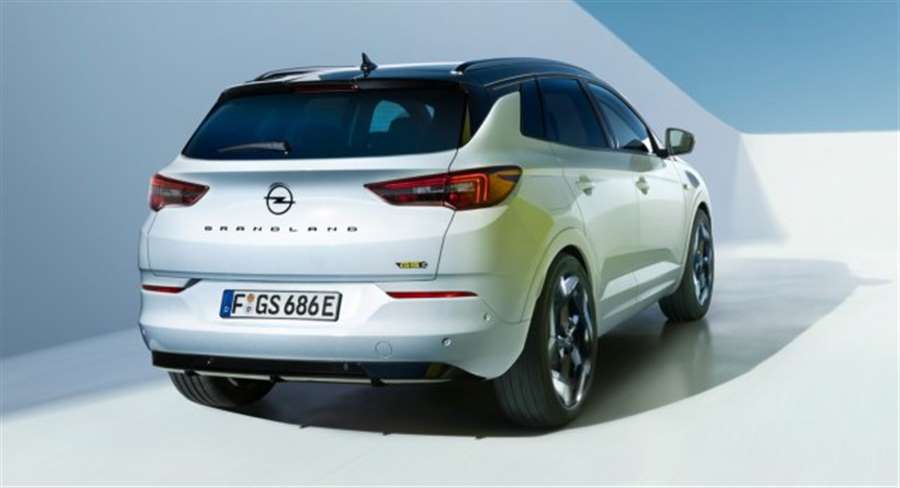
The Grandland GSe also owes its athletic nature to a set of 19-inch wheels inspired by the Manta GSe concept, a new diffuser and a GSe emblem on the tailgate.
A black hood is optional, matching the gloss black details on the emblem, fender vents, mirror housings, roof, spoiler and alloy wheels.
Like the regular facelifted Grandland, the GSe also features LED lights and the signature Opel Visor front fascia.
Inside we find a pair of AGR-certified sports seats upholstered in Alcantara, adding more lateral support without sacrificing comfort.
{vembed Y=0A7zgkYI-Ic}
As already mentioned, the drive system is a plug-in hybrid that combines a 1.6 turbo gasoline engine with two electric motors, which gives a total of 300 hp.
As expected, it is equipped with e-AWD all-wheel drive, and acceleration from 0 to 100 km/h is achieved in 6.1 seconds. The maximum speed is 235 km/h (135 km/h if driving exclusively on electric drive).
According to the WLTP, the consumption is 1.3 l/100 km, of course provided that you regularly charge the battery.
The GSe signature also indicates some additional modifications. Opel's SUV thus has stiffer springs and shock absorbers with KONI FSD (frequency selective damping) technology, which enables different damping characteristics for handling versus comfort.
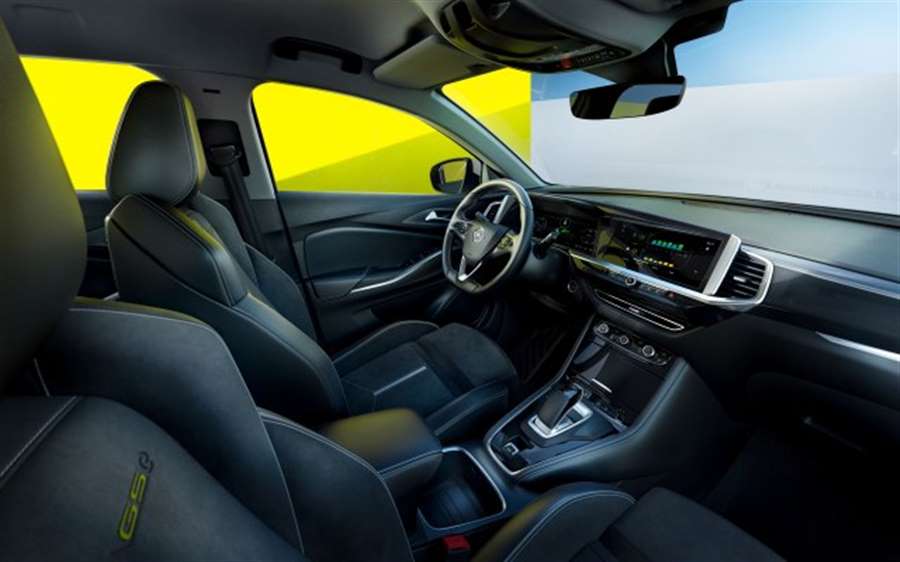
The price has not been announced yet, but Opel has announced that the Grandland GSe will arrive on the market soon.
2023 Toyota Crown Courts Controversy
Toyota embraces polemical design with the Avalon's tall four-door successor, the 2023 Crown.
Nobody ever argued about the Toyota Avalon, which was universally described as "perfectly nice." But Toyota, in case you haven't noticed, is no longer content with inoffensive competence. So it replaced the Avalon with the 2023 Crown, a jacked-up four-door coupe-roof sedan that looks like a 1999 Subaru Legacy SUS and a Local Motors Rally Fighter had a baby. The fact that this thing succeeds the Avalon reveals a lot about Toyota corporate culture right now, which we imagine as Rumspringa in Toyota City. What will it build next, and will it be the result of a dare?
The Crown—a nameplate that dates to 1955 in Japan—is 3.7 inches taller than a Camry and twice as extroverted. The high-riding stance is mostly posturing, given that the Crown's ground clearance is only 5.8 inches, just a tenth of an inch higher than the Camry's. But its optional 21-inch wheels look concept-car enormous on a vehicle this size, and the Platinum model's available two-tone paint brings some Maybach attitude to the near-luxury-sedan segment.
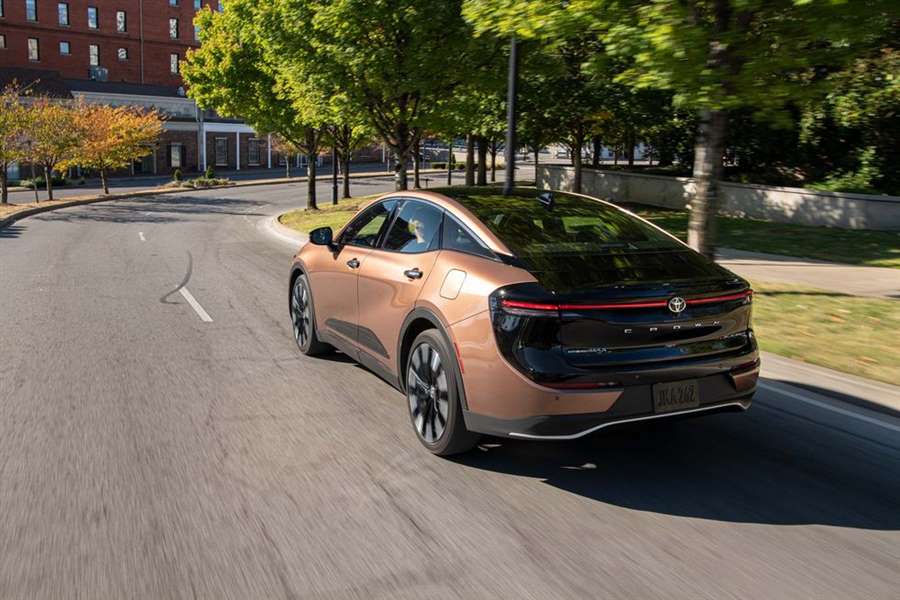
The Crown's two available hybrid powertrains differ in more than just power output. It's really like there are two Crowns—the base XLE and Limited for people who might actually be replacing an Avalon, as well as the Platinum Hybrid Max models that step brazenly into Lexus territory in terms of pricing and performance. All-wheel drive is standard either way, with the XLE and Limited using a naturally aspirated 2.5-liter four-cylinder paired with three electric motors to deliver a total of 236 horsepower through a continuously variable transmission. The rear axle is electric-only—there's no driveshaft—and its motor makes 54 horsepower and 89 pound-feet of torque. That's enough, Toyota tells us, to ensure that all-wheel drive remains available at all speeds, although we can't imagine the rear end is doing much if you boot it at 80 mph. This powertrain isn't the enthusiast choice, with Toyota claiming a safe and sane 7.6-second 60-mph time, but it does have an impressive EPA combined fuel-economy rating of 41 mpg. Curiously, while the revised 2023 Corolla Hybrid gets a lithium-ion high-voltage battery, the upmarket Crown sticks with nickel-metal hydride.
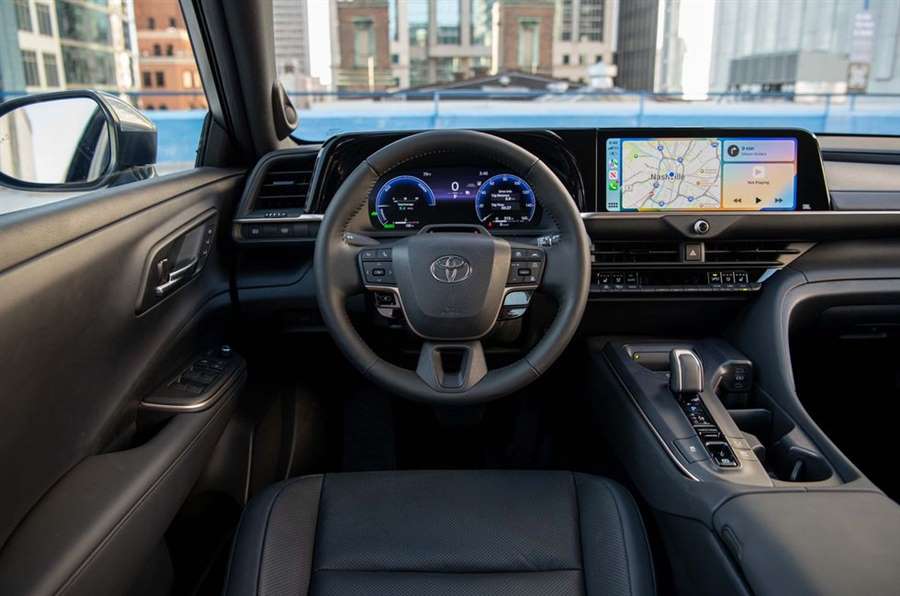
The optional Hybrid Max powertrain, available only in the Platinum, more closely aligns the Crown's performance with its bold sheetmetal. A turbocharged 2.4-liter four teams up with two electric motors to deliver 340 horsepower and 400 pound-feet of torque, while EPA combined fuel economy drops to 30 mpg. In the Max, the water-cooled rear motor makes 79 horsepower and 124 pound-feet and is always engaged (the base powertrain goes front-drive until the rear wheels need traction). Stacking the gains, Toyota bolts the turbo four to a six-speed automatic that uses a wet clutch instead of a torque converter. Hello, silky rev-matched downshifts. Intriguingly, the clutch will allow a high-rpm launch-control mode, which Toyota says is in the works and would likely drop the claimed 5.7-second 60-mph sprint even lower. The Platinum trim also gets adaptive dampers that make the Crown a surprisingly willing partner when the road gets twisty.
Inside, the Crown's cabin is reminiscent of the dearly departed Land Cruiser—not flashy but impeccably assembled with quality materials. It looks as if a scuffed driver's seat bolster might be the only tell when the odometer hits 200,000 miles. The Platinum's leather front seats are heated and ventilated, and the rear seats are also heated. The sleek climate control panel, immediately below the 12.3-inch touchscreen, would look perfectly at home in a $100,000 Lexus. The only letdown is the 11-speaker JBL audio system in the Limited and Premium (XLEs get a basic six-speaker system). The JBL sounds as if 10 of its 11 speakers might be tweeters, and yes, we checked the settings and tried different cars. Toyota says the system was "acoustically tuned for Toyota Crown to match unique vehicle characteristics," so maybe that means it expects the Crown demographic to listen to crime podcasts and NPR.
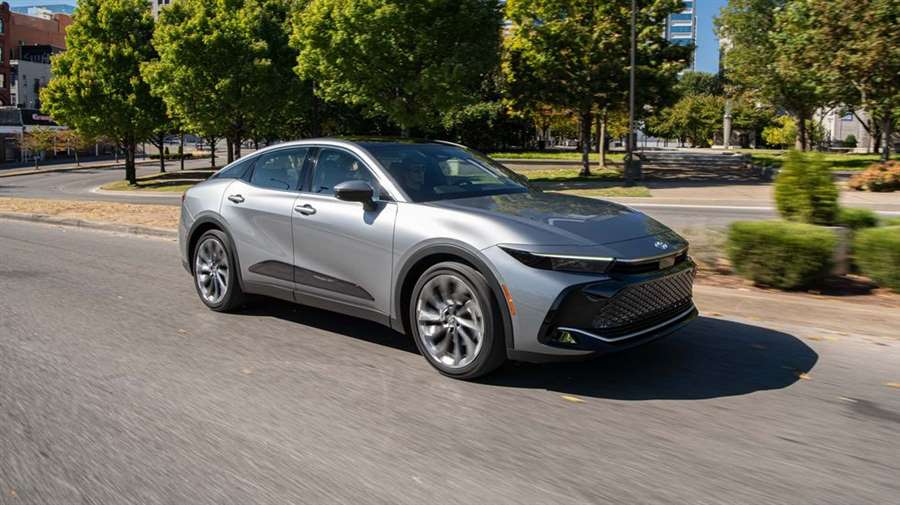
Like the old U.S.-market Land Cruiser, the Crown is built solely in Japan, at the Tsutsumi plant. And perhaps Toyota hopes that the Crown might capture a few orphan Land Cruiser owners in search of that signature anti-brand-snob Toyota luxury experience. Crown pricing starts at $41,045 for an XLE and ranges up to $53,445 for a Platinum. Is that too expensive for a Toyota sedan?
We'd say not, but the Crown's value proposition is up for debate as much as its style. Toyota hopes to sell about 20,000 Crowns a year in the U.S., which is a healthy goal but not one that demands mainstream conformity. Maybe you hate the way the Crown looks—that's fine. Toyota is fully aware haters gonna hate, and it truly doesn't care. If we're bickering over the Crown, we're talking about the Crown.
To that point, you don't offer two-tone paint if you're looking for unanimous consensus. That option, only available on the Platinum, brings a gloss black hood, roof, and rear decklid, set against extroverted lower-body colors like "Bronze Age." The two-tone paint costs $550 extra, and we'd say it's mandatory. But we'd be happy to argue about it.
Source: caranddriver.com

















